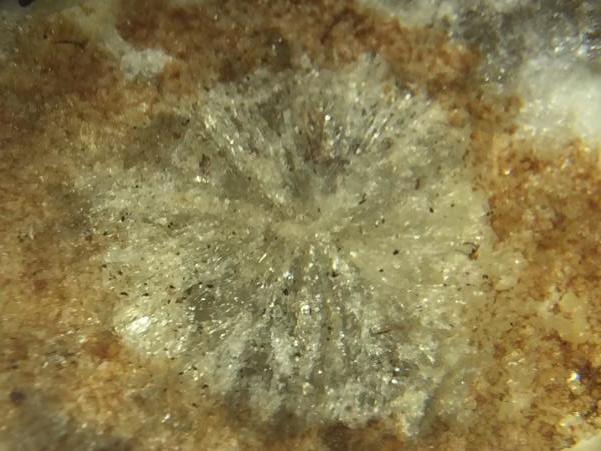Refikite
A valid IMA mineral species - grandfathered
This page is currently not sponsored. Click here to sponsor this page.
About Refikite
Formula:
C20H32O2
structural formula: (CH2)3C(CH3)(COOH)C(H)C(CH3)(CH2)2C(H)C(H)(CH2)3C=C3H6
Colour:
White to light yellow
Lustre:
Vitreous, Greasy, Pearly
Hardness:
1
Specific Gravity:
1.1334 (Calculated)
Crystal System:
Orthorhombic
Name:
Named after Refik-Bey (-1865), Turkish journalist interested in the sciences.
Type Locality:
Chemical name: abiet-13(15)-en-18-oic acid or (1R,4aR,4bS,8aS,10aR)-1,4a-dimethyl-7-propan-2-ylidene-3,4,4b,5,6,8,8a,9,10,10a-decahydro-2H-phenanthrene-1-carboxylic acid (and likely 1,4a-dimethyl-7-(1-methylidene)-tetradecahydrophenantrene-1-carboxylic acid).
Unique Identifiers
Mindat ID:
3384
Long-form identifier:
mindat:1:1:3384:4
GUID
(UUID V4):
(UUID V4):
3874b581-a9b7-4aad-80fa-a323a5870cf4
IMA Classification of Refikite
Approved, 'Grandfathered' (first described prior to 1959)
IMA Formula:
C20H34O2
First published:
1852
Classification of Refikite
10.CA.05
10 : ORGANIC COMPOUNDS
C : Miscellaneous Organic Minerals
A : Miscellaneous Organic Minerals
10 : ORGANIC COMPOUNDS
C : Miscellaneous Organic Minerals
A : Miscellaneous Organic Minerals
50.4.1.1
50 : ORGANIC COMPOUNDS
4 : Miscellaneous
50 : ORGANIC COMPOUNDS
4 : Miscellaneous
32.7
32 : Hydrocarbons, Resins and other Organic Compounds
32 : Hydrocarbons, Resins and other Organic Compounds
Mineral Symbols
As of 2021 there are now IMA–CNMNC approved mineral symbols (abbreviations) for each mineral species, useful for tables and diagrams.
| Symbol | Source | Reference |
|---|---|---|
| Ref | IMA–CNMNC | Warr, L.N. (2021). IMA–CNMNC approved mineral symbols. Mineralogical Magazine, 85(3), 291-320. doi:10.1180/mgm.2021.43 |
Physical Properties of Refikite
Vitreous, Greasy, Pearly
Comment:
Aggregates have pearly luster.
Colour:
White to light yellow
Hardness:
1 on Mohs scale
Tenacity:
Very brittle
Cleavage:
None Observed
Fracture:
Irregular/Uneven
Density:
1.1334 g/cm3 (Calculated)
Optical Data of Refikite
Type:
Biaxial
Chemistry of Refikite
Mindat Formula:
C20H32O2
structural formula: (CH2)3C(CH3)(COOH)C(H)C(CH3)(CH2)2C(H)C(H)(CH2)3C=C3H6
structural formula: (CH2)3C(CH3)(COOH)C(H)C(CH3)(CH2)2C(H)C(H)(CH2)3C=C3H6
Elements listed:
Crystallography of Refikite
Crystal System:
Orthorhombic
Class (H-M):
2 2 2 - Disphenoidal
Space Group:
P21 21 2
Cell Parameters:
a = 22.6520(7) Å, b = 10.3328(3) Å, c = 7.6711(2) Å
Ratio:
a:b:c = 2.192 : 1 : 0.742
Unit Cell V:
1,795.49 ų (Calculated from Unit Cell)
Z:
4
Morphology:
Polycrystalline crystals. Prismatic crystals, randomly intergrown, up to 11.5 mm in size.
Comment:
Cell data from Pažout et al. (2015).
X-Ray Powder Diffraction
Powder Diffraction Data:
| d-spacing | Intensity |
|---|---|
| 6.09 Å | (90) |
| 5.50 Å | (100) |
| 5.20 Å | (70) |
Comments:
Strongest lines reported by Fleischer (1965)
Geological Environment
Paragenetic Mode(s):
| Paragenetic Mode | Earliest Age (Ga) |
|---|---|
| Stage 10a: Neoproterozoic oxygenation/terrestrial biosphere | <0.6 |
| 50 : Coal and/or oil shale minerals | <0.36 |
| 53 : Other minerals with taphonomic origins | <0.4 |
Geological Setting:
In fossil roots of spruce in a swamp in southern Bavaria, Germany (Fleischer, 1965)
Type Occurrence of Refikite
General Appearance of Type Material:
White veins, 4-10 mm thick. Usually amorphous, rarely as radiating fibrous masses.
Place of Conservation of Type Material:
No designated type material.
Geological Setting of Type Material:
In lignite.
Other Language Names for Refikite
Related Minerals - Strunz-mindat Grouping
| 10.CA. | Tholins | (C,H,N) |
| 10.CA. | Natrosulfatourea | Na2(SO4)[CO(NH2)2] |
| 10.CA. | Allantoin | C4H6N4O3 |
| 10.CA. | Bojarite | Cu3(N3C2H2)3(OH)Cl2 · 6H2O |
| 10.CA.10 | Flagstaffite | C10H22O3 |
| 10.CA.15 | Hoelite | C14H8O2 |
| 10.CA.20 | Abelsonite | Ni(C31H32N4) |
| 10.CA.25 | Kladnoite | C6H4(CO)2NH |
| 10.CA.30 | Guanine | C5H5N5O |
| 10.CA.30 | Tinnunculite (of Chesnokov & Shcherbakova) | C10H12N8O8 |
| 10.CA.35 | Urea | CO(NH2)2 |
| 10.CA.40 | Uricite | C5H4N4O3 |
| 10.CA.45 | Chanabayaite | CuCl(N3C2H2)(NH3) · 0.25H2O |
| 10.CA.50 | Triazolite | NaCu2(N3C2H2)2(NH3)2Cl3 · 4H2O |
| 10.CA.55 | Ernstburkeite | Mg(CH3SO3)2 · 12H2O |
| 10.CA.60 | Joanneumite | Cu(C3N3O3H2)2(NH3)2 |
| 10.CA.65 | Tinnunculite | C5H4N4O3 · 2H2O |
| 10.CA.70 | Dopplerite |
Fluorescence of Refikite
Not fluorescent.
Other Information
Notes:
Insoluble in water.
Very soluble in ether and in concentrated and boiling alcohol, from which it separates on cooling and is deposited in needles grouped in stars
Melting point red as 179-183 °C.
Very soluble in ether and in concentrated and boiling alcohol, from which it separates on cooling and is deposited in needles grouped in stars
Melting point red as 179-183 °C.
Health Risks:
No information on health risks for this material has been entered into the database. You should always treat mineral specimens with care.
Internet Links for Refikite
mindat.org URL:
https://www.mindat.org/min-3384.html
Please feel free to link to this page.
Please feel free to link to this page.
Search Engines:
External Links:
References for Refikite
Reference List:
Localities for Refikite
Locality List
 - This locality has map coordinates listed.
- This locality has map coordinates listed.
 - This locality has estimated coordinates.
ⓘ - Click for references and further information on this occurrence.
? - Indicates mineral may be doubtful at this locality.
- This locality has estimated coordinates.
ⓘ - Click for references and further information on this occurrence.
? - Indicates mineral may be doubtful at this locality.
 - Good crystals or important locality for species.
- Good crystals or important locality for species.
 - World class for species or very significant.
(TL) - Type Locality for a valid mineral species.
(FRL) - First Recorded Locality for everything else (eg varieties).
- World class for species or very significant.
(TL) - Type Locality for a valid mineral species.
(FRL) - First Recorded Locality for everything else (eg varieties).
All localities listed without proper references should be considered as questionable.
Czech Republic | |
| |
Germany | |
| |
| |
Italy (TL) | |
| |
|
Quick NavTopAbout RefikiteUnique IdentifiersIMA Classification Classification Mineral SymbolsPhysical Properties Optical Data Chemistry Crystallography X-Ray Powder DiffractionGeological EnvironmentType Occurrence Other LanguagesStrunz-MindatFluorescence Other InformationInternet Links References Localities Locality List


 symbol to view information about a locality.
The
symbol to view information about a locality.
The 



Unnamed peat diggings, Kolbermoor, Rosenheim District, Upper Bavaria, Bavaria, Germany